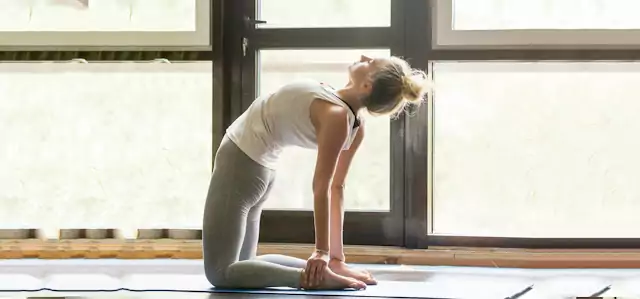A major cause of heart attacks, high blood pressure, or hypertension, can be kept under control by practising yoga.
Shashankasana
This asana is performed while sitting in Vajrasana. Keep your back, neck and head in a straight line and sit with your legs folded behind you. Take a deep breath and raise both hands in one straight line, keeping your head up. Now releasing your breath and keeping your head steady in between your shoulders, come down right to the ground, so both palms of your hands, your elbows and your forehead touch the ground. Make sure both your buttocks remain between both heels. They should not be raised. As you bend forward, release your breath. Start breathing normally when your head touches the ground. When you come up, breathe in. In this asana, your forehead should be touching the ground. This part of the head goes lower than the heart, so for a short while, blood circulation to the head is also increased and the heart does less work pumping blood to the brain.
Sukhpurvaka Pranayama
Sit in Lotus position or crossed legged on the floor. Keep the palm of your right hand facing your face. Bend the first two fingers next to your thumb and put your right thumb on your right nostril and use the last two fingers of the same hand to press your left nostril. Always start breathing with left side and finish with the left side. Breathe in through your left nostril. Close your left nostril and breathe out through your right. Breathe in through your right nostril. Breathe out through the left nostril. This becomes one round. Do a few more rounds like this every day, morning and evening, for at least five to 15 minutes.
Sivananda Pranayama
Lie down on the ground face up. Bend both legs from the knee. Knees should be kept pointing towards the sky and the heels of both the legs brought up to the buttocks, but not touching them. Keep the distance between the legs the same as the distance between your two shoulders. Keep both hands loose and a little apart from the body and thighs. Keep the palms of your hands facing up. Concentrate your mind on the solar plexus (navel) and start breathing deeply and slowly. Be aware of your breath. The more you can maintain this awareness, the greater control you have over your breathing and you will also be able to control your blood circulation system. You can practice Sivananda Pranayama for ten to fifteen minutes in the morning, noon, evening or late at night. It is great for high blood pressure, mental tension and stomach knots.
Shavasana
Lie down flat on your back. Relax your hands and legs. Listen to your heart beat and breathing. Observe your body from head to toe, starting with your feet and slowly moving up to your head. Become aware of your toes, feet, ankles, knees, leg muscles, buttocks, waist, back, belly, chest, both your hands and your arms, shoulders and face. These should all feel relaxed. Work through relaxing your body and mind and imagining your blood circulating perfectly smoothly through your body. This exercise effectively reduces muscular, emotional and mental tensions.
